WP 6.1 oversees three main tasks:
- developing programmable RNA editing protocols (UniBa, IFC-CNR and IIT)
- implementing native RNA sequencing technology (IIT)
- developing an optical microscopy platform (IIT)
WP 6.2 – Development of RNA-based and RNA-targeting compounds for therapeutic uses. WP 6.2 aims to design, select and characterize compounds with ‘beyond-state-of-the art’ properties in terms of selectivity, in vivo resistance, binding strength to the target, and control by external. The WP also focuses on optimizing a platform for mRNA therapeutics.
WP 6.2 oversees three main tasks:
- developing new RNA-targeting compounds (UniPD, UniBo, IC-CNR)
- setting fluorogenic / modulable RNA aptamers and synthetic DNA/RNA nanoscaffolds (IBB-CNR, IEOS-CNR, UniNA, UniSi,UniRoma2)
- creating new and more efficient methodology for the synthesis and formulation of chemically modified mRNAs (UniNa, UniPD)












